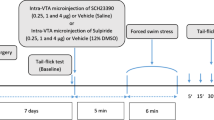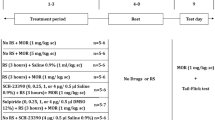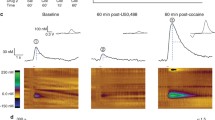Abstract
Rationale
Endogenous opioids could play a major role in the mesocorticolimbic dopamine (DA) responses to stress challenge. However, there is still no direct evidence of an influence of endogenous opioids on any of these responses.
Objective
We assessed whether and how endogenous opioids modulate fluctuations of mesocortical and mesoaccumbens DA tone in rats during a first experience with restraint stress.
Method
We first evaluated the effects of systemic naltrexone (NTRX) on DA outflow in the medial prefrontal cortex (mpFC) and in the nucleus accumbens (NAc) through dual-probe microdialysis. Second, we assessed the effect of perfusion, through reverse microdialysis, of direct DA receptor agonists in mpFC on NAc DA outflow in NTRX-pretreated stressed rats. Finally, we tested the effects of ventral tegmental area (VTA) perfusion of NTRX, the selective mu1 antagonist naloxonazine and the selective delta antagonist naltrindole on mpFC and NAc DA outflow in stressed rats, with multiple probe experiments.
Results
Systemic NTRX, at behaviorally effective doses, selectively prevented the increase of mpFC DA levels and the reduction of NAc DA levels observable during prolonged restraint. Local co-perfusion of D1 and D2 agonists in mpFC recovered inhibition of NAc DA in NTRX-pretreated restrained rats. Finally, intra-VTA perfusion of either NTRX or the mu1 antagonist, but not the delta antagonist, mimicked the effects of systemic NTRX.
Conclusion
During prolonged experience with a novel unavoidable/uncontrollable stressor, endogenous opioids, through stimulation of mu1 receptors in the VTA, elevate mesocortical DA tone thus reducing DA tone in the NAc DA.








Similar content being viewed by others
References
Altier N, Stewart J (1998) Dopamine receptor antagonists in the nucleus accumbens attenuate analgesia induced by ventral tegmental area substance P or morphine and by nucleus accumbens amphetamine. J Pharmacol Exp Ther 285(1):208–215
Amir S (1982) Involvement of endogenous opioids with forced swimming-induced immobility in mice. Physiol Behav 28(2):249–251
Bassareo V, Tanda G, Petromilli P, Giua C, Di Chiara G (1996) Non-psychostimulant drugs of abuse and anxiogenic drugs activate with differential selectivity dopamine transmission in the nucleus accumbens and in the medial prefrontal cortex of the rat. Psychopharmacology (Berlin) 124(4):293–299
Bland ST, Hargrave D, Pepin JL, Amat J, Watkins LR, Maier SF (2003) Stressor controllability modulates stress-induced dopamine and serotonin efflux and morphine-induced serotonin efflux in the medial prefrontal cortex. Neuropsychopharmacology 28(9):1589–1596
Bodnar RJ (2012) Endogenous opiates and behavior. Peptides 38(2):463–522
Cabib S, Puglisi-Allegra S (2012) The mesoaccumbens dopamine in coping with stress. Neurosci Biobehav Rev 36(1):79–89
Cabib S, Oliverio A, Puglisi-Allegra S (1989) Stress-induced decrease of 3-methoxytyramine in the nucleus accumbens of the mouse is prevented by naltrexone pretreatment. Life Sci 45(12):1031–1037
Cabib S, Zocchi A, Puglisi-Allegra S (1995) A comparison of the behavioral effects of minaprine, amphetamine and stress. Psychopharmacology (Berlin) 121(1):73–80
Charney DS (2004) Psychobiological mechanisms of resilience and vulnerability: implications for successful adaptation to extreme stress. Am J Psychiatry 161(2):195–216
Cruciani RA, Lutz RA, Munson PJ, Rodbard D (1987) Naloxonazine effects on the interaction of enkephalin analogs with mu-1, mu and delta opioid binding sites in rat brain membranes. J Pharmacol Exp Ther 242:15–20
Deutch AY, Clark WA, Roth RH (1990) Prefrontal cortical dopamine depletion enhances the responsiveness of mesolimbic dopamine neurons to stress. Brain Res 521(1–2):311–315
Devine DP, Leone P, Carlezon WA Jr, Wise RA (1993a) Ventral mesencephalic delta opioid receptors are involved in modulation of basal mesolimbic dopamine neurotransmission: an anatomical localization study. Brain Res 622(1–2):348–352
Devine DP, Leone P, Wise RA (1993b) Mesolimbic dopamine neurotransmission is increased by administration of mu-opioid receptor antagonists. Eur J Pharmacol 243(1):55–64
Devoto P, Flore G, Pira L, Diana M, Gessa GL (2002) Co-release of noradrenaline and dopamine in the prefrontal cortex after acute morphine and during morphine withdrawal. Psychopharmacology (Berlin) 160(2):220–224
Di Chiara G, Tanda G, Frau R, Carboni E (1993) On the preferential release of dopamine in the nucleus accumbens by amphetamine: further evidence obtained by vertically implanted concentric dialysis probes. Psychopharmacology (Berlin) 112(2–3):398–402
Doherty MD, Gratton A (1996) Medial prefrontal cortical D1 receptor modulation of the meso-accumbens dopamine response to stress: an electrochemical study in freely-behaving rats. Brain Res 715(1–2):86–97
Drolet G, Dumont EC, Gosselin I, Kinkead R, Laforest S, Trottier JF (2001) Role of endogenous opioid system in the regulation of the stress response. Prog Neuropsychopharmacol Biol Psychiatry 25:729–741
Drugan RC, Ader DN, Maier SF (1985) Shock controllability and the nature of stress-induced analgesia. Behav Neurosci 99(5):791–801
Drugan RC, Christianson JP, Warner TA, Kent S (2013) Resilience in shock and swim stress models of depression. Front Behav Neurosci 7:14
Espejo EF, Minano FJ (1999) Prefrontocortical dopamine depletion induces antidepressant-like effects in rats and alters the profile of desipramine during Porsolt’s test. Neuroscience 88(2):609–615
Filliol D, Ghozland S, Chluba J, Martin M, Matthes HW, Simonin F et al (2000) Mice deficient for delta- and mu-opioid receptors exhibit opposing alterations of emotional responses. Nat Genet 25(2):195–200
Floresco SB, West AR, Ash B, Moore H, Grace AA (2003) Afferent modulation of dopamine neuron firing differentially regulates tonic and phasic dopamine transmission. Nat Neurosci 6(9):968–973
Ghirmai S, Azar MR, Polgar WE, Berzetei-Gurske I, Cashman JR (2008) Synthesis and biological evaluation of alpha- and beta-6-amido derivatives of 17-cyclopropylmethyl-3, 14beta-dihydroxy-4, 5alpha-epoxymorphinan: potential alcohol-cessation agents. J Med Chem 51:1913–1924
Goto Y, Grace AA (2005) Dopaminergic modulation of limbic and cortical drive of nucleus accumbens in goal-directed behavior. Nat Neurosci 8(6):805–812
Grace AA, Floresco SB, Goto Y, Lodge DJ (2007) Regulation of firing of dopaminergic neurons and control of goal-directed behaviors. Trends Neurosci 30(5):220–227
Jalabert M, Bourdy R, Courtin J, Veinante P, Manzoni OJ, Barrot M et al (2011) Neuronal circuits underlying acute morphine action on dopamine neurons. Proc Natl Acad Sci U S A 108(39):16446–16450
Kalivas PW, Abhold R (1987) Enkephalin release into the ventral tegmental area in response to stress: modulation of mesocorticolimbic dopamine. Brain Res 414(2):339–348
King D, Zigmond MJ, Finlay JM (1997) Effects of dopamine depletion in the medial prefrontal cortex on the stress-induced increase in extracellular dopamine in the nucleus accumbens core and shell. Neuroscience 77(1):141–153
Lammel S, Lim BK, Ran C, Huang KW, Betley MJ, Tye KM et al (2012) Input-specific control of reward and aversion in the ventral tegmental area. Nature 491(7423):212–217
Ling GS, Simantov R, Clark JA, Pasternak GW (1986) Naloxonazine actions in vivo. Eur J Pharmacol 129:33–38
Lutz PE, Kieffer BL (2013) Opioid receptors: distinct roles in mood disorders. Trends Neurosci 36(3):195–206
Maier SF, Sherman JE, Lewis JW, Terman GW, Liebeskind JC (1983) The opioid/nonopioid nature of stress-induced analgesia and learned helplessness. J Exp Psychol Anim Behav Process 9(1):80–90
Margolis EB, Lock H, Chefer VI, Shippenberg TS, Hjelmstad GO, Fields HL (2006) Kappa opioids selectively control dopaminergic neurons projecting to the prefrontal cortex. Proc Natl Acad Sci U S A 103(8):2938–2942
Miller JD, Speciale SG, McMillen BA, German DC (1984) Naloxone antagonism of stress-induced augmentation of frontal cortex dopamine metabolism. Eur J Pharmacol 98(3–4):437–439
Molina VA, Heyser CJ, Spear LP (1994) Chronic variable stress or chronic morphine facilitates immobility in a forced swim test: reversal by naloxone. Psychopharmacology (Berlin) 114(3):433–440
Nicniocaill B, Gratton A (2007) Medial prefrontal cortical alpha1 adrenoreceptor modulation of the nucleus accumbens dopamine response to stress in Long-Evans rats. Psychopharmacology (Berlin) 191(3):835–842
Pascucci T, Ventura R, Latagliata EC, Cabib S, Puglisi-Allegra S (2007) The medial prefrontal cortex determines the accumbens dopamine response to stress through the opposing influences of norepinephrine and dopamine. Cereb Cortex 17(12):2796–2804
Paxinos G, Watson C (1998) The rat brain in stereotaxic coordinates. Academic, New York
Portoghese PS, Sultana M, Takemori AE (1988a) Naltrindole, a highly selective and potent non-peptide delta opioid receptor antagonist. Eur J Pharmacol 146:185–186
Portoghese PS, Sultana M, Nagase H, Takemori AE (1988b) Application of the message-address concept in the design of highly potent and selective non-peptide delta opioid receptor antagonists. J Med Chem 31:281–282
Puglisi-Allegra S, Imperato A, Angelucci L, Cabib S (1991) Acute stress induces time-dependent responses in dopamine mesolimbic system. Brain Res 554(1–2):217–222
Ribeiro SC, Kennedy SE, Smith YR, Stohler CS, Zubieta JK (2005) Interface of physical and emotional stress regulation through the endogenous opioid system and mu-opioid receptors. Prog Neuropsychopharmacol Biol Psychiatry 29:1264–1280
Rossetti ZL, Lai M, Hmaidan Y, Gessa GL (1993) Depletion of mesolimbic dopamine during behavioral despair: partial reversal by chronic imipramine. Eur J Pharmacol 242(3):313–315
Spanagel R, Herz A, Shippenberg TS (1992) Opposing tonically active endogenous opioid systems modulate the mesolimbic dopaminergic pathway. Proc Natl Acad Sci U S A 89(6):2046–2050
Svingos AL, Garzon M, Colago EE, Pickel VM (2001) Mu-opioid receptors in the ventral tegmental area are targeted to presynaptically and directly modulate mesocortical projection neurons. Synapse 41(3):221–229
Tanahashi S, Ueda Y, Nakajima A, Yamamura S, Nagase H, Okada M (2012) Novel delta1-receptor agonist KNT-127 increases the release of dopamine and L-glutamate in the striatum, nucleus accumbens and median pre-frontal cortex. Neuropharmacology 62(5–6):2057–2067
Tanda G, Di Chiara G (1998) A dopamine-mu1 opioid link in the rat ventral tegmentum shared by palatable food (Fonzies) and non-psychostimulant drugs of abuse. Eur J Neurosci 10(3):1179–1187
Tanda G, Bassareo V, Di Chiara G (1996) Mianserin markedly and selectively increases extracellular dopamine in the prefrontal cortex as compared to the nucleus accumbens of the rat. Psychopharmacology (Berlin) 123(2):127–130
Van Bockstaele EJ, Reyes BA, Valentino RJ (2010) The locus coeruleus: a key nucleus where stress and opioids intersect to mediate vulnerability to opiate abuse. Brain Res 1314:162–174
Ventura R, Cabib S, Puglisi-Allegra S (2002) Genetic susceptibility of mesocortical dopamine to stress determines liability to inhibition of mesoaccumbens. Neuroscience 115(4):999–1007
Acknowledgements
We thank Dr. Sergio Papalia for his skillful assistance. This work was supported by “Ricerca Corrente”, Italian Ministry of Health and Ateneo 2011, Sapienza University of Rome.
Author information
Authors and Affiliations
Corresponding author
Rights and permissions
About this article
Cite this article
Latagliata, E.C., Valzania, A., Pascucci, T. et al. Stress-induced activation of ventral tegmental mu-opioid receptors reduces accumbens dopamine tone by enhancing dopamine transmission in the medial pre-frontal cortex. Psychopharmacology 231, 4099–4108 (2014). https://doi.org/10.1007/s00213-014-3549-7
Received:
Accepted:
Published:
Issue Date:
DOI: https://doi.org/10.1007/s00213-014-3549-7




